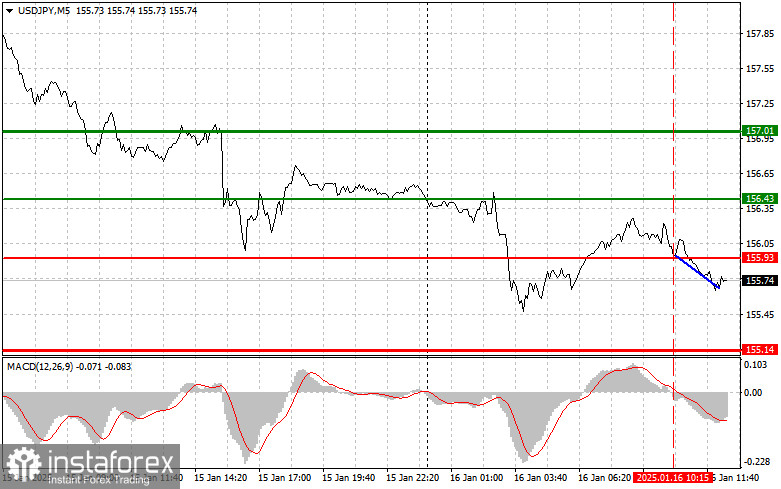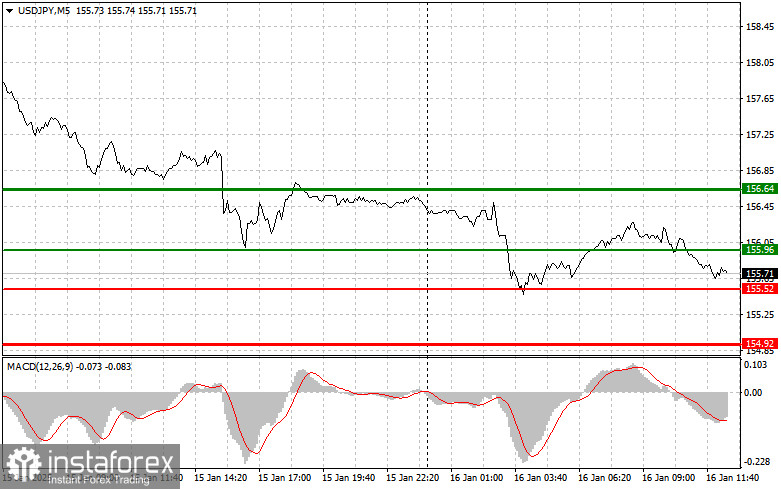Analysis and Trading Advice for USD/JPY
The test of the 155.93 level coincided with the MACD indicator starting its downward movement from the zero mark, confirming a valid sell entry for the dollar as part of the recent downward trend observed over the last few days. Following the 30-point decline, pressure on the dollar eased.
Japanese inflation data has been fully priced in, and the market's focus has now shifted to US data, which may assist in a dollar recovery. The number of initial jobless claims in the US remains a key economic indicator. Trends in this metric help analyze the state of employment and consumer confidence. A slight increase in claims over recent months suggests slowing market activity and employer caution, which could affect consumption and overall economic forecasts.
The retail sales figure is another crucial economic indicator, reflecting consumer spending trends, a significant component of GDP. Recent fluctuations in retail sales may be attributed to seasonal factors and changes in consumer behavior. Sustained growth in this sector is essential for positive economic momentum.
The Philadelphia Fed Manufacturing Index offers further insights into the economic climate in the manufacturing sector, signaling expansion or contraction in industrial activity.
Additionally, the highlight of the day will be a speech by FOMC member John Williams, who may share views on the current economic situation and the Federal Reserve's potential policy direction.
For intraday strategies, I will focus on implementing Scenario #1 and Scenario #2 in line with the ongoing downward trend.

Buy Signal
Scenario #1: I plan to buy USD/JPY at 155.96 (green line on the chart) with a target of 156.64 (thicker green line on the chart). At 156.64, I'll exit the buy trade and open sell positions, expecting a pullback of 30–35 points. A recovery in the pair is contingent on strong US data.Important: Before buying, ensure the MACD indicator is above the zero mark and just starting to rise from it.
Scenario #2: I will also consider buying USD/JPY after two consecutive tests of the 155.52 level when the MACD indicator is in oversold territory. This scenario would limit the pair's downward potential and trigger a market reversal upward. The targets are 155.96 and 156.64.
Sell Signal
Scenario #1: I plan to sell USD/JPY after breaking below 155.52 (red line on the chart), likely leading to a sharp decline. The key target for sellers will be 154.92, where I will exit sales and immediately open buy trades, expecting a pullback of 20–25 points. Further downward pressure on the pair is expected within the ongoing downward trend.Important: Before selling, ensure the MACD indicator is below the zero mark and just starting to decline from it.
Scenario #2: I will also consider selling USD/JPY after two consecutive tests of the 155.96 level when the MACD indicator is in overbought territory. This would limit the pair's upward potential and trigger a downward reversal. The targets are 155.52 and 154.92.

Chart Legend
- Thin Green Line: Entry price for buying the instrument.
- Thick Green Line: Anticipated price for setting Take Profit or manually locking in profits, as further growth above this level is unlikely.
- Thin Red Line: Entry price for selling the instrument.
- Thick Red Line: Anticipated price for setting Take Profit or manually locking in profits, as further declines below this level are unlikely.
- MACD Indicator: When entering the market, consider overbought and oversold zones.
Important Notes
Beginner traders on the Forex market must exercise extreme caution when making trading decisions. Before major fundamental reports are released, it's advisable to stay out of the market to avoid sharp price fluctuations. If trading during news events, always set stop-loss orders to minimize losses. Without stop-loss orders, you risk losing your entire deposit, especially when trading large volumes without proper money management.
Remember, successful trading requires a well-defined plan like the one outlined above. Spontaneous trading decisions based on current market conditions are inherently a losing strategy for intraday traders.





















